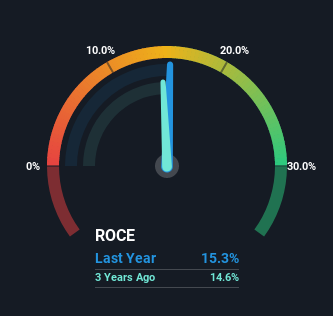
If you're not sure where to start when looking for the next multi-bagger, there are a few key trends you should keep an eye out for. Amongst other things, we'll want to see two things; firstly, a growing return on capital employed (ROCE) and secondly, an expansion in the company's amount of capital employed. Ultimately, this demonstrates that it's a business that is reinvesting profits at increasing rates of return. So, when we ran our eye over Bureau Veritas' (EPA:BVI) trend of ROCE, we liked what we saw.
What Is Return On Capital Employed (ROCE)?
For those who don't know, ROCE is a measure of a company's yearly pre-tax profit (its return), relative to the capital employed in the business. To calculate this metric for Bureau Veritas, this is the formula:
Return on Capital Employed = Earnings Before Interest and Tax (EBIT) ÷ (Total Assets - Current Liabilities)
0.15 = €756m ÷ (€7.1b - €2.2b) (Based on the trailing twelve months to June 2022).
Therefore, Bureau Veritas has an ROCE of 15%. On its own, that's a standard return, however it's much better than the 11% generated by the Professional Services industry.
View our latest analysis for Bureau Veritas

Above you can see how the current ROCE for Bureau Veritas compares to its prior returns on capital, but there's only so much you can tell from the past. If you'd like to see what analysts are forecasting going forward, you should check out our free report for Bureau Veritas.
How Are Returns Trending?
While the returns on capital are good, they haven't moved much. The company has employed 25% more capital in the last five years, and the returns on that capital have remained stable at 15%. 15% is a pretty standard return, and it provides some comfort knowing that Bureau Veritas has consistently earned this amount. Over long periods of time, returns like these might not be too exciting, but with consistency they can pay off in terms of share price returns.
Our Take On Bureau Veritas' ROCE
In the end, Bureau Veritas has proven its ability to adequately reinvest capital at good rates of return. However, over the last five years, the stock has only delivered a 21% return to shareholders who held over that period. So to determine if Bureau Veritas is a multi-bagger going forward, we'd suggest digging deeper into the company's other fundamentals.
One more thing to note, we've identified 2 warning signs with Bureau Veritas and understanding them should be part of your investment process.
While Bureau Veritas may not currently earn the highest returns, we've compiled a list of companies that currently earn more than 25% return on equity. Check out this free list here.
Valuation is complex, but we're here to simplify it.
Discover if Bureau Veritas might be undervalued or overvalued with our detailed analysis, featuring fair value estimates, potential risks, dividends, insider trades, and its financial condition.
Access Free AnalysisHave feedback on this article? Concerned about the content? Get in touch with us directly. Alternatively, email editorial-team (at) simplywallst.com.
This article by Simply Wall St is general in nature. We provide commentary based on historical data and analyst forecasts only using an unbiased methodology and our articles are not intended to be financial advice. It does not constitute a recommendation to buy or sell any stock, and does not take account of your objectives, or your financial situation. We aim to bring you long-term focused analysis driven by fundamental data. Note that our analysis may not factor in the latest price-sensitive company announcements or qualitative material. Simply Wall St has no position in any stocks mentioned.
About ENXTPA:BVI
Bureau Veritas
Provides laboratory testing, inspection, and certification services.
Excellent balance sheet with proven track record and pays a dividend.


